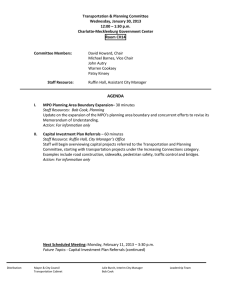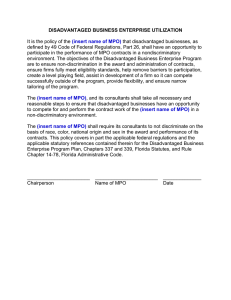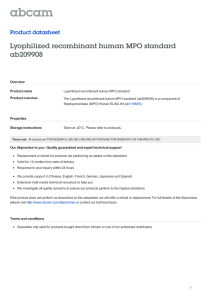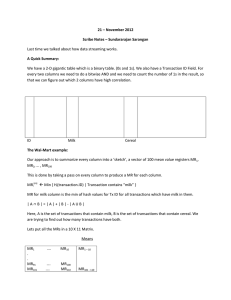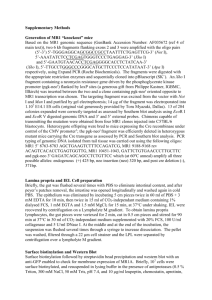Evaluation of post-industrial and post-consumer polyolefin
advertisement
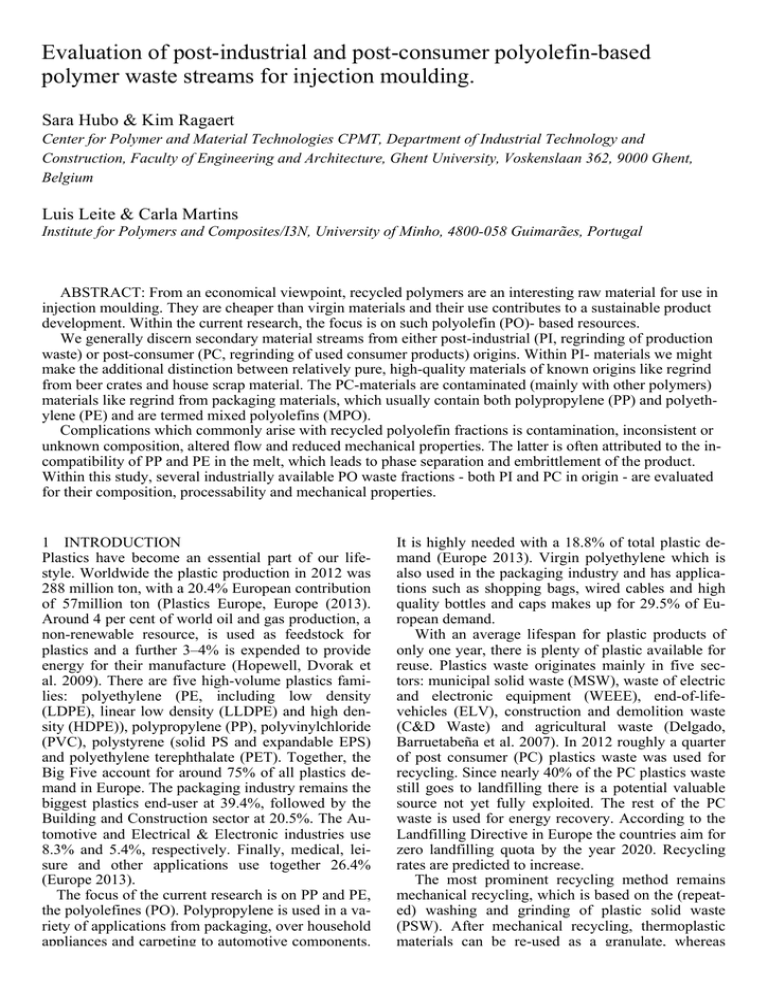
Evaluation of post-industrial and post-consumer polyolefin-based polymer waste streams for injection moulding. Sara Hubo & Kim Ragaert Center for Polymer and Material Technologies CPMT, Department of Industrial Technology and Construction, Faculty of Engineering and Architecture, Ghent University, Voskenslaan 362, 9000 Ghent, Belgium Luis Leite & Carla Martins Institute for Polymers and Composites/I3N, University of Minho, 4800-058 Guimarães, Portugal ABSTRACT: From an economical viewpoint, recycled polymers are an interesting raw material for use in injection moulding. They are cheaper than virgin materials and their use contributes to a sustainable product development. Within the current research, the focus is on such polyolefin (PO)- based resources. We generally discern secondary material streams from either post-industrial (PI, regrinding of production waste) or post-consumer (PC, regrinding of used consumer products) origins. Within PI- materials we might make the additional distinction between relatively pure, high-quality materials of known origins like regrind from beer crates and house scrap material. The PC-materials are contaminated (mainly with other polymers) materials like regrind from packaging materials, which usually contain both polypropylene (PP) and polyethylene (PE) and are termed mixed polyolefins (MPO). Complications which commonly arise with recycled polyolefin fractions is contamination, inconsistent or unknown composition, altered flow and reduced mechanical properties. The latter is often attributed to the incompatibility of PP and PE in the melt, which leads to phase separation and embrittlement of the product. Within this study, several industrially available PO waste fractions - both PI and PC in origin - are evaluated for their composition, processability and mechanical properties. 1 INTRODUCTION Plastics have become an essential part of our lifestyle. Worldwide the plastic production in 2012 was 288 million ton, with a 20.4% European contribution of 57million ton (Plastics Europe, Europe (2013). Around 4 per cent of world oil and gas production, a non-renewable resource, is used as feedstock for plastics and a further 3–4% is expended to provide energy for their manufacture (Hopewell, Dvorak et al. 2009). There are five high-volume plastics families: polyethylene (PE, including low density (LDPE), linear low density (LLDPE) and high density (HDPE)), polypropylene (PP), polyvinylchloride (PVC), polystyrene (solid PS and expandable EPS) and polyethylene terephthalate (PET). Together, the Big Five account for around 75% of all plastics demand in Europe. The packaging industry remains the biggest plastics end-user at 39.4%, followed by the Building and Construction sector at 20.5%. The Automotive and Electrical & Electronic industries use 8.3% and 5.4%, respectively. Finally, medical, leisure and other applications use together 26.4% (Europe 2013). The focus of the current research is on PP and PE, the polyolefines (PO). Polypropylene is used in a variety of applications from packaging, over household appliances and carpeting to automotive components. It is highly needed with a 18.8% of total plastic demand (Europe 2013). Virgin polyethylene which is also used in the packaging industry and has applications such as shopping bags, wired cables and high quality bottles and caps makes up for 29.5% of European demand. With an average lifespan for plastic products of only one year, there is plenty of plastic available for reuse. Plastics waste originates mainly in five sectors: municipal solid waste (MSW), waste of electric and electronic equipment (WEEE), end-of-lifevehicles (ELV), construction and demolition waste (C&D Waste) and agricultural waste (Delgado, Barruetabeña et al. 2007). In 2012 roughly a quarter of post consumer (PC) plastics waste was used for recycling. Since nearly 40% of the PC plastics waste still goes to landfilling there is a potential valuable source not yet fully exploited. The rest of the PC waste is used for energy recovery. According to the Landfilling Directive in Europe the countries aim for zero landfilling quota by the year 2020. Recycling rates are predicted to increase. The most prominent recycling method remains mechanical recycling, which is based on the (repeated) washing and grinding of plastic solid waste (PSW). After mechanical recycling, thermoplastic materials can be re-used as a granulate, whereas thermosets can only be grinded for further use as a filler agent. Quality of composition is the main issue when dealing with mechanically recycled polymers. The post industrial (PI) waste, generated in manufacturing, processing, and distribution of plastic products is well suited for the use as a raw material for mechanical recycling (Al-Salem, Lettieri et al. 2009), as this PI-material usually consist of only one (known) polyolefin. As the PI-waste is produced inside an industry, the composition, possible contamination and homogeneity of these materials are well controlled. In contrast, the post-consumer materials are a mixture of different plastic resins generally contaminated with dirt or other residues. Recycling of PC-material is then much more difficult. Within this research, some industrially available recycled PO-materials are examined and evaluated in terms of composition, processing-related and mechanical properties. The material selection comprises both PI- and PC-materials, of different compositions and quality/price grades. 2 EXPERIMENTAL 2.2 Injection moulded test specimens In order to examine the mechanical properties, test bars were produced. All the materials were injection moulded at an injection temperature of 230°C, with an exception of the PE containing PC3(PEpp) and PI4(PE) which were processed at 190°C. The injected part contains two types of test bars: dog-bone shape and rectangular shape, of which the mould dimensions are given in Table 2. For the dog bone specimen, both the dimensions of the tensile testing area (‘narrow’) and those of the overall part are given. Table 2. Dimensions of test bars Shape Dog bone Rectangular (mm) (mm) Narrow Overall Width 6 18 13 Height* 4 4 3 Length 33 114 126 *In accordance with standard EN ISO 527-1 height difference of Δh ≤ 0,1 mm shall be acceptable in the tensile bars. 2.1 Materials All the materials were kindly provided by Flemish companies, which are partners of CPMT in the collective research project IWT-TETRA 130181. They are all recycled PO, both PI and PC, of undisclosed origins, in the form of shredded particles or regranulates. The materials are categorized according to price, in a low cost (<600€/T) or a medium cost (>800€/T) range. By means of reference, the current price of virgin polyethylene is about 1200 €/T and that of polypropylene is about 1500€/T. Table 1 gives an overview of the selected materials, their content and there cost. The materials are labeled according to type (PI or PC) and composition (between brackets). Recycled materials which are known and marketed to be MPO are marked as such. Recycled materials which are meant to be ‘pure’ PE or PP are marked as such in capital letters. If these are in fact contaminated with the other polyolefin, this is marked by adding the contaminating polymer in small letters). For example, PI2(PPpe) is a postindustrial material, no.2, mostly made of PP, but also containing a small amount of PE. Table 1. PI and PC polyolefin waste materials Material Price range Form PI1(PP) > 800 €/T shredded PI2(PPpe) > 800 €/T shredded PI3(PPpe) > 800 €/T shredded PI4(PE) > 800 €/T shredded PI5(MPO) < 600 €/T shredded PC1(MPO) < 600 €/T shredded PC2(MPO) < 600 €/T regranulate PC3(PEpp) < 600 €/T shredded 2.3 Composition and processing-related properties 2.3.1 FTIR Fourier-transform infrared spectroscopy (FTIR) measurements were performed on the injection moulded parts, according to the ASTM E168, E1252 standards, as a means to obtain an insight in the composition of the materials. The instrument used is a Bruker tensor 27, with OPUS (vs 6.5) software and an ATR-crystal. Additionally, out of the PC1(MPO) batch, a randomly chosen 100 particles were subjected to FTIR analysis in order to gain a representative evaluation of the overall composition. 2.3.2 MFI The melt flow index (MFI) of the materials was monitored according to ISO 1133 at a temperature of 230°C, and load of 2.16 kg on a Zwick plastometer 4100 instrument, based on the mass-measurement method. MFI (g/10min) was determined after milling the materials to exclude size differences. The cutting interval was 60s with a Zwick cutting device. Reported values are an average of at least six measurements. 2.3.3 Density The density was gravimetrically determined by means of a density kit and a Precisa balance, according to ISO 1183-1. Reported values are an average of at least five measurements. 2.3.4 DSC The thermal properties of the materials were investigated by differential scanning calorimetry (DSC) on a Netzsch DSC 204 F1 apparatus and later analyzed with Netzsch Proteus Thermal Analysis (vs 5.0.1) software, according to EN ISO 11358. There was first a background measurement and then about 20 mg of an injection moulded sample was heated on an aluminum crucible in the furnace in a nitrogen atmosphere from 20°C to 600°C at heating rate of 10°C/min. The same rate was used for cooling. The temperature program was repeated twice so as to erase the thermal history of the material. the elastic deformation region), extension was continued until break at a higher rate. Reported values are an average of at least ten measurements. 2.4 Mechanical properties 3 RESULTS AND DISCUSSION 2.4.1 Impact test The rectangular shaped test bars were tested for impact properties according to the Charpy method. They were notched 2 mm using a notch cutter to bring the overall width to 11 mm. The samples were placed edgewise, covering a span of 64 mm. The pendulum energy was 2.75 J, except for the PC3(PEpp) where a 5 J hammer had to be used in order to obtain a complete break (instead of partial break at 2.75 J). Tensile impact strength, was measured at 23°C using a Zwick tester an with the testXpertII software, according to the ISO 179 norm. The values obtained are presented as the means of the measurements on ten specimens. 3.1 Composition - FTIR 2.4.2 Flexural properties The same test bars as for impact test were used to determine the flexural modulus in a three point bending test, considering the ISO 179-1 standard. The instrument was an Instron 4301 with Bluehill software (vs 2.6). An Instron static load cell of 2kN was used. The test bars were placed over a support span of 64 mm. The crosshead was set to a speed of 10 mm/min and the end of test criterion was a flexural indentation of 5 mm. The modulus along with the flexure stress and the flexure strain at maximum flexure were calculated. Reported values are the mean of at least 7 measurements. 2.4.3 Tensile properties The dog bone shaped test bars, were used to determine the tensile strength and the tensile modulus of elasticity. The instrument used is an Instron 5565, with Bluehill (vs 2.15) software and an Instron static load cell of 2kN, considering the EN ISO 527 standard. Over the elastic region, specimen were loaded at 10 mm/min. An extensometer (gauge length 25 mm, compliant with ISO 9513, class 1) was used for strain measurement in the initial part of the test, where modulus is determined. After removal of the extensometer (at either 2 or 5 % strain, value outside 2.5 Data processing All data were run though a statistical software program, SPSS Statistics 22 and screened for outliers. The outliers were deleted in order to work within the 95% confidence interval. Typical values for properties of virgin polymers were taken from a well-known materials science textbook (Callister 2012). The results of the FTIR analysis are listed in Table 3, including the hit quality (promille) of the matches made. These measurements give a first indication of the composition, which can be corroborated by DSC analysis further on. Table 3 FTIR hit result quality (promille) for the presence of LDPE, HDPE, PP and blends (N: no hit) Material LDPE HDPE PP Blend PI1(PP) N N 836 N PI2(PPpe) N N 804 706 PI3(PPpe) 579 539 613 583 PI4(PE) 832 803 N N PI5(MPO) 792 735 531 N PC1(MPO) 544 511 676 609 PC2(MPO) 522 490 548 548 PC3(PEpp) 595 600 N N PI1(PP) shows no PE presence, whereas PI4(PE) shows no PP presence, also not in the form of some sort of blend. These materials are therefore considered to effectively be pure. PI2(PPpe) appears to be contaminated with PE, as indicated by the relatively good hit in ‘blends’. For all other materials, FTIR suggests the presence of LDPE, albeit with a relatively low hit quality (<600‰) in many cases. Based on these data, PC3(PEpp) would not appear to contain any PP. As PC materials are more likely to contain contaminations from other polymers, a more extensive analysis was conducted on one of these materials. Out of PC1(MPO) 100 grains were randomly selected an their content determined by FTIR. The results are presented in Figure 1. As expected, the bulk of the MPO is made up by PP (nearly 60%) and PE (nearly 30%). Important contaminants are, non-PO materials and even wood. The test could not determine with surety the exact nature of the non-PO material, but many of these samples contain a styrene group, suggesting PS and/or ABS. The wood contamination is most likely possible because the wood will float with the polymers during float-sink separation steps in the recycling process. 3.3 Density Recorded density values and their standard deviations are presented in Table 5. Table 5. Density values of polyolefin waste materials Material Mean density (g /cm³) PI1(PP) 0.896± 0.001 PI2(PPpe) 0.905 ± 0.000 PI3(PPpe) 0.918 ± 0.002 PI4(PE) 0.943 ± 0.002 PI5(MPO) 0.954 ± 0.004 PC1(MPO) 0.943 ± 0.002 PC2(MPO) 0.974 ± 0.007 PC3(PEpp) 0.932 ± 0.003 Figure 1. Estimated polymer content of PC1(MPO) 3.2 MFI Especially for the PC materials, quite some difficulties occurred to get a steady flow in the MFI experiments, despites the milling previous to the test. This resulted in quite large variations on MFI measurements for some materials, especially PC1(MPO). There were most likely traces of at least one other polymer, not entirely liquefied at 230°C, which blocked the capillary. As suggested earlier by FTIR, this may have been PS and/or ABS. The MFI values are listed in Table 4, with their respective standard deviations. In Figure 2, these values are plotted against the common values of density for PP (0.905 g/cm³, indicated with a full line), LDPE (0.925 g/cm³) indicated with a widely dotted line) and HDPE (0.959 g/cm³) indicated with a closely dotted line). The PI1(PP) material has a density value that lies below the average value of PP, which is attributed to remnant foaming agents in the material. PI4(PE) is clearly positioned between the HDPE and LDPE average values. Figure 2. Density values of polyolefin waste materials. Table 4. MFI values of polyolefin waste materials Material Mean MFI (g/10 min) PI1(PP) 7.68 ± 0.47 PI2(PPpe) 8.10 ± 0.16 PI3(PPpe) 10.63 ± 0.47 PI4(PE) 11.57 ± 0.09 PI5(MPO) 9.98 ± 0.54 PC1(MPO) 7.63 ± 1.09 PC2(MPO) 3.59 ± 0.27 PC3(PEpp) 5.48 ± 0.52 In general, the MFI values of the post-consumer materials are lower than those of the post-industrial materials, indicating a more difficult flow. This can be a direct influence of the content, since in general the post-consumer waste is of various origins with multiple polyolefins. From these experiments, it was clear that the standardized MFI test (developed for virgin material) is not entirely suitable for recycled polymers, due to the ease with which the small capillary may be obstructed. It would be beneficial to further research on the flow of recycled polymer streams to develop a more robust method for the determination of MFI, which is less affected by the changing composition of these materials. The PC2(MPO) which went through a step of regranulation, has a markedly higher density than the other PC materials. The lower amount of contamination is attributed to the melt filtration step in the regranulating process. As noted also in FTIR, PI3(PPpe) appears to be more contaminated with PE than PI2(PPpe), which is expressed in a higher density value. 3.4 DSC Melting temperature Tm and crystallization temperature Tc (upon cooling) were evaluated from the first and second heating runs for each sample. The focus lies on the melting range of PP and PE, roughly be- tween 100°C and 200°C. A clear peak indicates the presence of PP and the presence of PE, with a possible classification as HDPE and/or LDPE. In general, the PP peak temperatures can be found near 175°C, stated as the typical melting temperature for polypropylene. The HDPE peak temperatures can be found near the specific value of 137°C, stated as typical for HDPE, whereas LDPE shows a typical value at 115°C. The DSC data in table 5 are considered together with the FTIR results from Table 3. Table 5. DSC melting temperatures LDPE, HDPE and PP peaks of polyolefin waste materials (°C) Tm, LDPE Tm,HDPE Tm,PP Tc Typical val- 115 137 175 ue (°C) PI1(PP) 170.4 121.9 PI2(PPpe) 128.4 168.5 122 PI3(PPpe) 136.3 167 116.1 & 122.4 PI4(PE) 141.4 112.7 PI5(MPO) 135.6 165.9 113.4 & 121.2 PC1(MPO) 135.9 169 116.1 PC2(MPO) 112.9 126.5 163.7 110.4 & 119.9 PC3(PEpp) 135.1 164.2 112.1 The distinctive peaks are used to make a qualitative assessment of the composing polyolefines. In general it can be presumed that PP is present in all the samples except PI4(PE). Both experiments confirm that PI1(PP) is indeed pure PP and PI4(PE) is indeed pure PE, with no contamination by the other PO. Both PI2(PPpe) and PI3(PPpe) contain both PP and HDPE, but it can be deduced that the amount must be much smaller in PI2(PPpe) as it does not appear as a separate hit in FTIR (only a ‘blend’ hit) and no separate PE crystallization is noted for this material. Also, density for PI3(PPpe) was noted to be higher, further corroborating the larger amount of PE. FTIR suggests also LDPE in PI3(PPpe), but no separate melting peak for LDPE was distinguished during DSC, indicating that if the LDPE is there at all, it is most likely also a small amount. In PI5(MPO), the peaks for PE and PP are clearly distinguished separately both during melting and crystallization. DSC indicates that the composing PE is in in fact HDPE and not a mix of LDPE and HDPE, as previously suggested by FTIR measurement. It is only in PC2(MPO) that a separate LDPE peak can be discerned, even if FTIR suggested the presence of LDPE for all PC materials. Together with the high density value of 0,946 g/cm³ we can conclude a significant presence of foil LDPE material in this post-consumer waste stream. For all other materials, the presence of LDPE is considered negligible. While a distinct melting peak was observed for PP in PC3(MPO), there is no separate peak during crystallization. Instead, a shoulder is noted on a broader crystallization peak, which is more centered around the temperatures relevant for PE. Combined with the fact that FTIR did not report a hit on PP, it is concluded that PP content in PC3(MPO) is present, but relatively low. 3.5 Impact properties Results from the impact testing are presented in Table 6. As the common impact strength ranges for both PP (2-95 kJ/m²) and PE (2-110 kJ/m²) are quite broad, it is not considered useful to compare to average values for virgin materials. Table 6. Impact results for polyolefin waste materials (kJ/m²) Material Mean impact strength (kJ/m²) PI1(PP) 10.07 ± 0.57 PI2(PPpe) 8.11 ± 0.77 PI3(PPpe) 8.98 ± 0.83 PI4(PE) 5.90 ± 0.16 PI5(MPO) 4.31 ± 0.48 PC1(MPO) 3.22 ± 0.15 PC2(MPO) 9.88 ± 1.12 PC3(PEpp) 27.75 ± 3.74 The PP-based PI materials display reasonable impact properties. It is plausible that these polymers would have been previously impact-modified as a known source for PI regranulate are products like crates and floor panels. Likewise, PC3(PEpp) may contain such additives, as it displays the highest impact resistance of all materials tested. Concerning the MPO materials, both PI5(MPO) and PC1(MPO) have quite poor impact resistance, with values below 5 kJ/m². This is primarily attributed to the immiscibility of PP and PE in the melt, which leads to phase separation and reduced impact properties. For these materials, it would be advisable to incorporate a small amount of compatibilizing agent during processing. Additionally, contaminations by other polymers (as reported for PC1(MPO)) will function as weak spots, making the product more brittle. PC2(MPO) however, displays better impact resistance. This could be caused by the extra regranulating step, in which impurities are largely removed by melt filtration and the compounding during granulation may lead to homogenization of the blend. 3.6 Tensile and flexural properties Results for the tensile and flexural modulus are reported in Table 7, along with tensile strength σt. Although theoretically, modulus values should be the same in bending as in tension, the here experimentally reported Eflex are generally lower than Et. This is a common observation, which is attributed to the fact that in bending the load is applied transversally to the polymer chains instead of along their oriented direction. For the recycled materials tested within this research, a significantly larger variation was noted on the results for tensile modulus Et than flexural modulus Eflex. This is due to the fact that impurities will have a more pronounced weakening effect under tensile loading than in a bending setup. Likewise, this has a major impact on strain at break. Variation on those results was so large that they are not considered meaningful and are not reported. Table 7. Tensile and flexural properties. Material Eflex [MPa] Et [MPa] PI1(PP) 954 ± 62 1141 ± 41 PI2(PPpe) 1169 ± 42 1520 ± 137 PI3(PPpe) 781 ± 48 1032 ± 91 PI4(PE) 851 ± 21 1045 ± 121 PI5(MPO) 867 ± 85 910 ± 52 PC1(MPO) 1095 ± 95 1096 ± 81 PC2(MPO) 569 ± 31 632 ± 110 PC3(PEpp) 797 ± 34 763 ± 132 σt [MPa] 23 ± 0.5 26 ± 0.6 22 ± 0.9 23 ± 0.7 17 ± 0.5 14 ± 0.5 14 ± 0.6 20 ± 1.5 The modulus values found for the PP-based PI1(PP) and PI2(PPpe) are conform to the common range of PP (1100-1550 MPa). It was concluded earlier from FTIR and DSC results that the PE contamination of PI2(PPpe) was quite small and indeed, the material displays mechanical properties typical of PP. To the contrary, FTIR, DSC and density measurements all suggested a larger PE contamination in PI3(PPpe) and indeed, modulus values are notably lower, due to this PE content. The PE-based materials PI4(PE) and PC3(PEpp) evidence somewhat lower mechanical properties, leaning indeed more towards the typical ranges between HDPE (around 1000 MPa) and LDPE (below 300 MPa). Concerning the MPO materials, modulus values are equally between those typical for PP and PE, but the weakening effect of the aforementioned phase separation between the composing PO can clearly be observed in the significantly lower tensile strength. Specifically for PC2(MPO), the distinct presence of LDPE which was identified earlier clearly contributes to a reduced mechanical strength. 4 CONCLUSIONS AND OUTLOOK A selection of industrially available PI and PC recycled polymer materials have been evaluated on their composition, physicochemical and mechanical properties. In general, the more expensive PI materials have a purer composition and more predictable properties. Determining composition of recycled PO has been demonstrated to rely on the combined analysis of different experiments (density, FTIR, DSC) and is not possible through a single straightforward test. Especially for the cheaper PC materials this is the case, as the origins of the material are even more obscure than for their PI counterparts. The main weakness noted for the MPO materials, was their impact strength, which is severely reduced because of suspected phase separation in the melt. The pre-treatment of these MPO materials can have a significant effect on their properties; it was observed that regranulated PC2(MPO) (containing LDPE, HDPE and PP) benefited from its melt filtration and compounding step through higher density and impact properties. For future work, it will be our endeavor to increase the applicability of the cheaper MPO materials, by blending with higher-quality PI materials and/or adding a compatibilizing agent to improve the phase boundaries between the PP and PE components. 5 ACKNOWLEDGEMENTS This research was funded by IWT, the Flemish Agency for Science and Technology. The research is part of the IWT-TETRA project 130181 ‘Design, mould making and processing parameters for the injection moulding of recycled polyolefines’. 6 REFERENCES Al-Salem, S. M., P. Lettieri and J. Baeyens (2009). Recycling and recovery routes of plastic solid waste (PSW): a review. Waste Manag 29(10): 2625-2643. Callister, W. D. (2012). Fundamentals of Materials Science and Engineering: SI Version, John Wiley & Sons Canada, Limited. Delgado, C., L. Barruetabeña and O. Salas (2007). Assessment of the environmental advantages and drawbacks of the existing and emerging polymers recovery processes. PlasticsEurope, (2013). Plastics – the Facts 2013 An analysis of European latest plastics production, demand and waste data, Plastics Europe. Hopewell, J., R. Dvorak and E. Kosior (2009). Plastics recycling: challenges and opportunities. Philos Trans R Soc Lond B Biol Sci 364(1526): 2115-2126.

